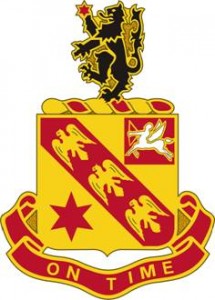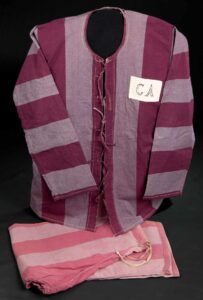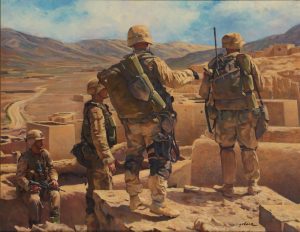By Dallas Looney
In the aftermath of World War II, the U.S. Army faced a significant challenge. The conflict in Europe had proven that armored warfare was going to be of paramount importance to any future conflict. With the eyes of the Army upon the ever-rising Soviet influence across the world, the need for a powerful main battle tank was necessary.

The story of the M48 Patton Main Battle Tank begins with its predecessor, the M47 Patton. Under a program in 1949 to replace the tanks used in World War II, a program hampered by cuts in defense spending after World War II, the M47 would be an evolution from the M26 Pershing Heavy Tank, first deployed late in World War II in Europe, and the M46 Patton, essentially an upgraded Pershing. The M26’s significant mobility and mechanical problems limited its effectiveness. Furthermore, threats overseas, including the Red Army’s huge numerical advantage in tanks, emphasized a desperate need for improved tanks to counter any Soviet threat.

The M47 was a direct response to a growing need for better American armor spurred on by the North Korean People’s Army’s use of Soviet-made T-34s, especially in the opening weeks of the war. While American tankers performed admirably in Korea, they were equipped with tanks from a prior war, and issues of firepower, armor protection, and reliability could not be ignored. Perhaps most dangerous was the introduction of the Soviet IS series of heavy tanks, the first of which, the IS-2, was introduced to the Red Army late in World War II. It was armed with an impressive 122mm gun and protected by up to 110mm armor, features no tanks in the West could match.

Despite many cutting-edge innovations, the M47 proved to be a problematic vehicle as it was rushed into production. Instead, the American armored force continued to operate M46s and even the all-but-obsolete M26 Pershing. It was pressingly obvious that in order to meet the ever-encroaching Soviet threat, the United States would need to push forward development of an upgraded M47. Numerous projects sought to answer this glaring issue, but none was more critical to the advancement of the Army’s armored power than the T48 project. Launched in May 1950 with the goal of enhancing the performance of the M47, the T48 project also sought to mount a powerful T139 90mm main gun and install an improved gasoline engine. The Army then contracted with Chrysler Defense for the design and production of the new tank.
Further developments followed, with the driver’s position relocated from the left-front to the center-front of the hull and the assistant driver and hull machine gun eliminated. In addition, the T48 replaced lever steering with an aircraft-like yoke, allowing the driver to make more effective coordinated actions without having to utilize multiple levers for a single maneuver. An upgraded, more powerful engine, the Continental AV-1790-5B gasoline engine, generated 704 brake horsepower and was coupled with the Allison CD-850-4A cross-drive transmission. Innovations such as composite applique panels made from fused silica glass provided further armor protection to the hull and turret of the tank. The T48’s fire control system contained a rangefinder, mechanical ballistic computer, ballistic drive, and a gunner’s site.
With these changes development continued at a more rapid pace, leading to a number of T48 prototypes, which advanced toward field testing in December 1950 at the Ordnance Tank Automotive Command (OTAC) Detroit Arsenal Test Center. In February 1951, the T48 project evolved under the designation 90mm Gun Tank M48. Specifications included a weight of 40.8 tons/90,000 pounds, a four-man crew, and a 90mm main gun. The first functioning prototype with both a chassis and a turret was built by Chrysler in Michigan in January 1952 and faced its first trials in Fort Knox, Kentucky. However, complications and slow development followed. With the Army’s goal of 9,000 M48s within the span of three years, it was evident that a serious move toward modernizing the Army’s tank program was being put forward.
The M48 was officially designated the Patton after General George S. Patton, Jr., the famed pioneer of Army armored doctrine and legendary commander of the U.S. Third Army during World War II. The first production M48 was unveiled on 1 July 1952 and christened by Mrs. Beatrice Ayer Patton, the widow of the late general.

Nearly 12,000 M48s were built by the Chrysler, General Motors Fisher Body Division, Ford Motor Company, and the American Locomotive Company from 1952 to 1961. Despite the innovations heralded in development, the M48 continued to face problems during its initial rollout, most notably engine, suspension, and transmission issues. Due to these concerns, M48s operated within the United States until they were fit to be used overseas by both the Army and the Marine Corps, finding notable use in Fort Knox for training tank crews.
Production models of the M48 weighed 49.6 tons and had a length of 30 feet, 6 inches (9.3 meters) with gun forward, a width of 12 feet (3.65 meters), and a height of 10 feet, 2 inches (3.1 meters). Hull armor protection was 120mm front, 76mm sides, 44mm rear, and 57mm top. Turret armor was 110mm on the front, 76mm on the turret sides, 50mm at the turret rear, and 25mm on top. All variants had a top speed of approximately thirty miles per hour and, depending on the variant, a range of 70 to 310 miles (113 to 499 kilometers).

The M48’s main armament was the 90mm M41/T139 gun. The gun originally used a y-shaped muzzle brake but tank crews complained that it tended to snag brush when on maneuvers, so this was later changed to the more characteristic t-shaped one early in production. It could carry up to sixty-four rounds of 90mm ammunition. Secondary armament included an M2 Heavy Barrel (HB) .50 caliber machine mounted on the turret, originally on an M1 mount and later in an enclosed cupola, and an M1919 .30 caliber machine gun mounted coaxially in the turret with the main gun.
During the 1950s and early 1960s, the M48 was developed in three main variants. The M48A1, produced from 1952 to 1956, was a notable improvement upon what was largely viewed as a lackluster tank. To improve its range, the M48A1 utilized four external fuel drums upon the rear of the chassis. Further improvements included a wider driver’s hatch and an infrared vision block. The variant also included an M1 cupola and an improved CD-850-4B transmission, enhancing the previous cross-drive capability. Issues continued to plague this variant, ranging from the engine to the M12 stereoscopic rangefinder. Over 7,000 M48A1s were manufactured and they were rushed to Army units deployed in Europe as a show of force against the Soviets. During the Berlin Crisis of 1961, M48A1s faced off with Soviet T-54s at Checkpoint Charlie during one of the most contentious periods of the Cold War.
The M48 continued to be a point of contention amongst the Defense Department as deadlines and requirements for modernization lagged. In a move to try and simplify the production process, Defense officials tried to direct a singular production line with the Chrysler Corporation ending up being the sole manufacturer of all M48s by the end of 1956. Competing with the T95 Tank Program, the M48 was in somewhat of a dangerous position, with far more experimental options for advancement being suggested. One such suggestion was to utilize a nuclear power plant within the tank itself, though this idea was scrapped as highly impractical. The hull and suspension were redesigned, with particular attention paid to the removal of the track tensioner arm and the addition of bumper springs and friction snubbers. Utilizing a smaller but more powerful AVI-1790-8 engine, the M48A2 moved a great portion of its fuel reserves to the engine compartment for a total of 335 gallons. Further modifications included the M113 Fire Control System with a M5A2 ballistic drive and a mechanical M13A3 gun data computer, as well as a M20 day periscope with a magnification of 8x and a M105D day telescopic sight with a field of view of 7.5 degrees. From 1955 to 1957, the M48A2 was produced and shipped to Army units across the world.

Despite these and other improvements, the M48’s troubles did not cease. With complications and hazards regarding the gasoline engine, Army officials suggested replacing it with a diesel engine, and OTAC recommended the Continental AVDS-1790. Another improvement was made with the implementation of the M1E1 cupola which provided the tank commander more headroom and allowed him to reload the M2HB .50 caliber machine gun while under armor protection. These and other modifications were incorporated into the M48A3, produced from 1957 to 1961. The M48A3 became the quintessential American tank of the Vietnam War. A variant that saw considerable service Vietnam was the M67 Flamethrower Tank, nicknamed the “Zippo,” after the popular cigarette lighter, which saw the M48’s 90mm main gun replaced with a flamethrower.
The Army deployed over 600 M48s to South Vietnam during the war in Southeast Asia. Initially deployed in 1965 with U.S. Marine tank units, the Army eventually sent three armor battalions equipped with M48s: 1st Battalion, 77th Armor; 1st Battalion 69th Armor; and 2d Battalion, 34th Armor. Additional M48s equipped other units in Vietnam, such as the 11th Armored Cavalry Regiment and divisional cavalry squadrons. Due to the lack of tank-on-tank battles, the M48 was largely relegated to providing fire support for the infantry and at firebases. M48s also provided security for truck convoys and were effective at “jungle busting” operations. Canister rounds were particularly effective against masses of enemy infantry, and high explosive and white phosphorus rounds proved more than capable of dealing with Viet Cong and North Vietnamese Army (NVA) bunkers and other positions. One of the few armored battles of the war was the 3-4 March 1969 Battle of Ben Het. Occurring near the Vietnam-Laos-Cambodia border, four M48s from Company B, 1st Battalion, 69th Armor, supporting a 5th Special Forces Group camp, clashed with several NVA PT-76 tanks and a number of BTR-50 armored personnel carriers in a night battle. NVA losses amounted to two PT-76s and one BTR-50 destroyed. One American M48 suffered a direct hit to its turret that killed two crewmen and wounded a third.

The armies of several U.S. allies equipped their armor units with M48s, including West Germany, Greece, Turkey, Spain, Pakistan, South Vietnam, Taiwan, and Israel. Israeli M48s met Soviet-made tanks of Egypt and Syria on the field of battle during the Six-Day War in 1967. The mobility and technical prowess of the M48A2s and M48A3s overshadowed the superior firepower of the IS-3s used by Egypt. Israeli M48s later faced Egyptian and Syrian tanks in the 1973 Yom Kippur War and took part in some of the largest armored battles since World War II. Pakistan employed M48s in its two wars with India in 1965 and 1971. Later in early October 1993, Pakistani M48s took part in the rescue of American special operations soldiers during the Battle of Mogadishu.
Even after its service in so many wars, the M48’s journey was not yet done. After a brief prototype aiming to combine both the T95E4 turret and the M48A2 hull, development shifted to establishing the M48A5 variant. Seen as the last upgrade to the original M48 design in 1975, this variant retrofitted existing M48s with a number of changes, including the addition of an M68/T254E2 105mm main gun, an M219 7.62mm coaxial machine gun, an AVDS-1790-2D V-12, twin-turbo diesel engine, and 300-gallon fuel capacity. The M48A5 also featured the M13A1 Nuclear, Biological, and Chemical crew protection system. This variant was used more for training National Guardsmen rather than frontline service. By 1973, the M48 had been all but withdrawn from Regular Army units. The last National Guard unit to retire the M48 was 1st Battalion, 632d Armor, of the Wisconsin Army National Guard in May 1987.

In addition to the M67 variant equipped with a flamethrower, other M48 variants included the M48 Armored Vehicle-Launched Bridge and a series of armored combat engineer vehicles. Before its cancellation in 1985, the M247 Sergeant York Division Air Defense system incorporated the chassis of the M48A1. After the M48 was withdrawn from U.S. service, many tanks not sent overseas as military foreign aid or put on display at museums or outside National Guard armories became targets at various military ranges across the country.
Over time the, M48 would find itself overshadowed by the development of the M60 line of tanks. With its implementation mired in bureaucracy and development gridlock, the M48 served as a snapshot into the dedication of post-World War II Army armor innovation. Perhaps no better summation of the story of the M48 exists than of General Bruce C. Clarke’s famous statement: “We know exactly what we want. We want a fast, highly mobile, fully armored, lightweight vehicle. It must be able to swim, cross any terrain, and climb 30-degree hills. It must be air-transportable. It must have a simple but powerful engine, requiring little or no maintenance. The operating range should be several hundred miles. We would also like it to be invisible.” While the M48 certainly missed the mark on a few of those goals, overall, it was an effective tank for the U.S. Army and its allies and holds an important place in the history of American armor.



